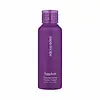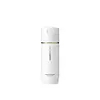What's inside
What's inside
 Key Ingredients
Key Ingredients

 Benefits
Benefits

 Concerns
Concerns

No concerns
 Ingredients Side-by-side
Ingredients Side-by-side

Zea Mays Starch
AbsorbentSodium Cocoyl Isethionate
CleansingSodium Lauroyl Glutamate
Diglycerin
HumectantBetaine
HumectantSodium Cocoyl Glycinate
CleansingJuglans Regia Shell Powder
AbrasiveAllantoin
Skin ConditioningGlucose
HumectantMaltodextrin
AbsorbentPapain
Skin ConditioningCI 77742
Cosmetic ColorantWater
Skin ConditioningButylene Glycol
HumectantPropanediol
SolventDipropylene Glycol
HumectantSolanum Melongena Fruit Extract
Skin Conditioning1,2-Hexanediol
Skin ConditioningGlycerin
HumectantGanoderma Lucidum Extract
Skin ProtectingLentinus Edodes Extract
Skin ConditioningLactobacillus Ferment
Skin ConditioningSparassis Crispa Extract
Emulsion StabilisingTrametes Versicolor Extract
Hyaluronic Acid
HumectantHydrolyzed Hyaluronic Acid
HumectantSodium Hyaluronate
HumectantPrunus Amygdalus Dulcis Fruit Extract
Skin ConditioningTremella Fuciformis Extract
HumectantTabebuia Impetiginosa Bark Extract
Skin ConditioningEthylhexylglycerin
Skin ConditioningZea Mays Starch, Sodium Cocoyl Isethionate, Sodium Lauroyl Glutamate, Diglycerin, Betaine, Sodium Cocoyl Glycinate, Juglans Regia Shell Powder, Allantoin, Glucose, Maltodextrin, Papain, CI 77742, Water, Butylene Glycol, Propanediol, Dipropylene Glycol, Solanum Melongena Fruit Extract, 1,2-Hexanediol, Glycerin, Ganoderma Lucidum Extract, Lentinus Edodes Extract, Lactobacillus Ferment, Sparassis Crispa Extract, Trametes Versicolor Extract, Hyaluronic Acid, Hydrolyzed Hyaluronic Acid, Sodium Hyaluronate, Prunus Amygdalus Dulcis Fruit Extract, Tremella Fuciformis Extract, Tabebuia Impetiginosa Bark Extract, Ethylhexylglycerin
Mannitol
HumectantSodium Cocoyl Glycinate
CleansingSodium Lauroyl Glutamate
Zeolite
AbsorbentSilica
AbrasiveBetaine
HumectantAllantoin
Skin ConditioningPotassium Laurate
EmulsifyingPolycaprolactone
StabilisingParfum
MaskingZea Mays Starch
AbsorbentPEG-75
HumectantDipotassium Glycyrrhizate
HumectantDisodium EDTA
Trehalose
HumectantWater
Skin ConditioningButylene Glycol
HumectantPapain
Skin ConditioningLactobacillus Ferment Lysate
Skin ConditioningCI 19140
Cosmetic ColorantZingiber Officinale Root Extract
MaskingZiziphus Jujuba Fruit Extract
Skin ConditioningCamellia Sinensis Leaf Extract
AntimicrobialMannitol, Sodium Cocoyl Glycinate, Sodium Lauroyl Glutamate, Zeolite, Silica, Betaine, Allantoin, Potassium Laurate, Polycaprolactone, Parfum, Zea Mays Starch, PEG-75, Dipotassium Glycyrrhizate, Disodium EDTA, Trehalose, Water, Butylene Glycol, Papain, Lactobacillus Ferment Lysate, CI 19140, Zingiber Officinale Root Extract, Ziziphus Jujuba Fruit Extract, Camellia Sinensis Leaf Extract
Ingredients Explained
These ingredients are found in both products.
Ingredients higher up in an ingredient list are typically present in a larger amount.
Allantoin is a soothing ingredient known for its protective and moisturizingg properties. Because of this, it is often added to products with strong active ingredients.
Studies show higher concentrations of this ingredient can promote wound healing.
Though it can be derived from the comfrey plant, allantoin is produced synthetically for cosmetic products to ensure purity.
Learn more about AllantoinBetaine is a common humectant (a substance that promotes retention of moisture). It's known to be gentle on the skin and can help balance hydration.
This ingredient is best for improving hydration and soothing irritated skin. Studies also show it helps even out skin tone.
Fun fact: Betaine is naturally created in the skin and body. The kind found within cosmetic products can be either plant-derived or synthetic.
Another name for betaine is trimethylglycine.
Learn more about BetaineButylene Glycol (or BG) is used within cosmetic products for a few different reasons:
Overall, Butylene Glycol is a safe and well-rounded ingredient that works well with other ingredients.
Though this ingredient works well with most skin types, some people with sensitive skin may experience a reaction such as allergic rashes, closed comedones, or itchiness.
Learn more about Butylene GlycolPapain is an enzyme found naturally in the papaya plant's leaves, fruit, and roots. It has antimicrobial, soothing, and wound healing properties.
Glycine and Vitamin A are naturally found in papain.
While papain is often touted as skin-lightening, further studies are needed to prove this. However, papain has been shown to help soothe acne-inflammation.
Papain belongs to a class of enzymes called proteolytic enzymes. These enzymes break down peptides and amino acids.
Some studies found papain to be a potential skin sensitizer and allergen. Those with latex allergies might also be allergic to papaya.
Learn more about PapainSodium Cocoyl Glycinate is a cleansing agent. It can be naturally derived or synthetically-created.
As a surfactant, it helps clean your skin by gathering dirt, oil, and other pollutants to be rinsed away more easily.
Sodium Lauroyl Glutamate is the sodium salt from the lauric acid of glutamic acid.
It is a surfactant and helps cleanse the skin. Surfactants gather oil, dirt, and other pollutants from your skin so they may be washed away easily.
Water. It's the most common cosmetic ingredient of all. You'll usually see it at the top of ingredient lists, meaning that it makes up the largest part of the product.
So why is it so popular? Water most often acts as a solvent - this means that it helps dissolve other ingredients into the formulation.
You'll also recognize water as that liquid we all need to stay alive. If you see this, drink a glass of water. Stay hydrated!
Learn more about WaterZea Mays Starch is starch made from corn. You might know this as cornstarch . It is used to thicken a product. It can replace talc as an absorbent.
The pH of cornstarch is 5.92.
Cornstarch is a common food ingredient used to thicken soups or to make corn syrup.
Learn more about Zea Mays Starch